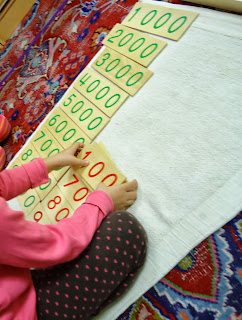On an unseasonably warm Friday, the late morning autumn sun shines on us. A group of children runs, chasing each other's shadows. Another group gathers at the picnic table, collecting rocks, leaves, and twigs to play a game of 'store' while closely inspecting their fine specimens from nature. I watch, quietly. One of the children who is chasing shadows comes straight to me - arms reaching out as he gets closer. The hug nearly knocks me over and while I steady myself, another one comes from the side... and yet another from the other side! "Wow!" I say as I stumble along, trying not to fall. The children shout with glee, "Everyone, hug!" When I finally catch my balance, one of the children declares, "Ms. Sasha, you almost fell, but we held you up!" And at that moment, all traces of self-doubt were erased. It is so true - what would I do without those smiling faces, the hugs, or even the occasional tears? Thank you, children for your wisdom, reassurance, and reminder that we the best we can do is keep moving forward, knowing that all is well! :-)
Some photos from this week:
 |
| Spooning teff - a traditional grain of Ethiopia, perfect for our study of Africa. |
 |
| Pouring water into two containers. |
 |
| More teff - this time using a small funnel. |
 |
| Fine motor control with green colored water and a water dropper. |
 |
| Reading practice: three-letter phonetic reading cards. |
 |
| Filling the shape of Africa with play-dough. |
 |
| Counting by tens with the Tens Boards and golden beads. |
 |
Writing practice with Metal Insets.
|
 |
| Visual discrimination of size with the Knobless Cylinders. |
 |
| Working on number recognition with the teen beads and Teen Boards. |
 |
| Taking care of classroom plants. |
 |
| Introduction of the Stamp Game. |
 |
| Addition with the colored beads. |
 |
| Static addition with the Stamp Game. |
 |
| Beginning sounds and symbols with the Language Step Board. |
 |
| Linear counting with the Tens Boards and beads. |
 |
Reading practice with three-part phonetic reading cards/pictures.
|
 |
| Writing the names of African animals with the Moveable Alphabet - 'gorilla' and 'giraffe.' |
 |
| Exciting exploration of the Pink Tower and Brown Stair - "Look, it doesn't even fall!" |
 |
| Sorting images of animals from different continents. |
 |
| Function of Words lesson with grammar symbols. |
 |
Working with the Lacing Frame.
|
 |
Filling up the compartment of the Spindle Boxes by first counting the corresponding number of spindles in the hand. This gives a strong sensorial impression of quantity while highlighting the concept of zero.
|
 |
| Introduction to the Decimals System Cards. |
 |
| Learning the names of countries in Africa with the Puzzle Map of Africa. |
 |
| Number writing practice with the Sandpaper Numbers. |
 |
| Folding napkins - what a great lesson to heighten awareness of precision of movement and coordination! |
 |
Reading practice with the Phonetic Object Box.
|
 |
| "Meow..." |
 |
| ...having fall fun, creating outside. |














































































